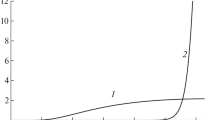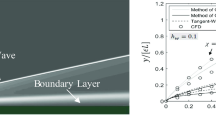Abstract
The formation of a boundary layer on a semiinfinite plate behind a moving shock wave is described by singular parabolic-type equations with “elliptical” boundary conditions. A supplementary condition at a fixed section [1–3] is set for the Prandtl equation in Crocco form describing traditional conditions on the wall, on the external boundary, and in the initial section. The integral ratio method [4, 5] is employed for each of the regions where the coefficient of the first derivative does not change sign. The differential equation system obtained has two singular points, in the vicinity of which nondegenerate transformation produces a system with a diagonal matrix which is then integrated. The original system is solved numerically, the values of asymptotic solutions being chosen as “initial” conditions. The calculations are presented as approximate functions obtained on the basis of systematic calculations and expansion of the Prandtl equation solution in the shock-wave intensity parameter α = U∞/U.
Similar content being viewed by others
Literature cited
Yu. A. Dem'yanov, “Boundary-layer formation on a plate with moving compression discontinuity,” Prikl. Mat. Mekh.,21, No. 3 (1957).
S. H. Lam and L. Crocco, “Note on the shock-induced unsteady laminar boundary layer on a semiinfinite flat plate,” J. Aero-Space Sci.,26, No. 1 (1959).
M. Gevrey, “Sur les equations aux derivees partielles du type parabolique,” J. Math. Pures Appl., Ser. 6,9, No. 4 (1913);10, No. 2 (1914).
A. A. Dorodnitsyn, “A method for solution of laminar boundary-layer equations,” Zh. Prikl. Mekh. Tekh. Fiz., No. 3 (1960).
Yu. A. Dem'yanov and V. V. Feoktistov, “Use of the integral ratio method in solution of a singular parabolic-type equation arising in boundary-layer theory,” Zh. Vychisl. Mat. Mat. Fiz.,15, No. 2 (1975).
H. Mirels, “Boundary layer behind shock or thin expansion wave moving into stationary fluid,” Nat. Advis. Comm. Aeronaut. Techn. Notes, No. 3712 (1956).
K. Stewartson, “On the impulsive motion of a flat plate in viscous fluid,” Quart. Mech. Appl. Math.,4, Pt. 1 (1951).
E. D. Feldermen, “Heat exchange and tangent stress in the transient boundary layer formed on a plane plate upon passage of a shock wave,” Raketn. Tekh. Kosmonavt.,6, No. 3 (1968).
L. Kennedy, “Impulsive motion of a semiinfinite plate in a viscous fluid,” Appl. Sci. Res.,27, No. 5 (1973).
Author information
Authors and Affiliations
Additional information
Translated from Izvestiya Akademii Nauk SSSR, Mekhanika Zhidkosti i Gaza, No. 1, pp. 32–42, January–February, 1976.
Rights and permissions
About this article
Cite this article
Dem'yanov, Y.A., Feoktistov, V.V. Numerical solution of the problem of boundary-layer formation on a plate behind a moving shock wave. Fluid Dyn 11, 28–37 (1976). https://doi.org/10.1007/BF01023391
Received:
Issue Date:
DOI: https://doi.org/10.1007/BF01023391




